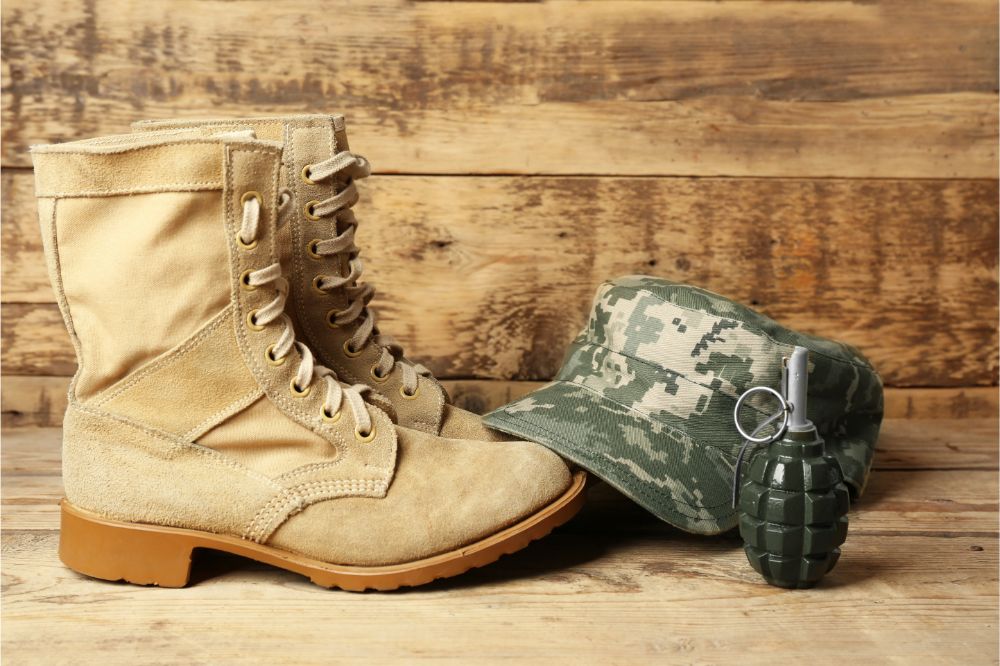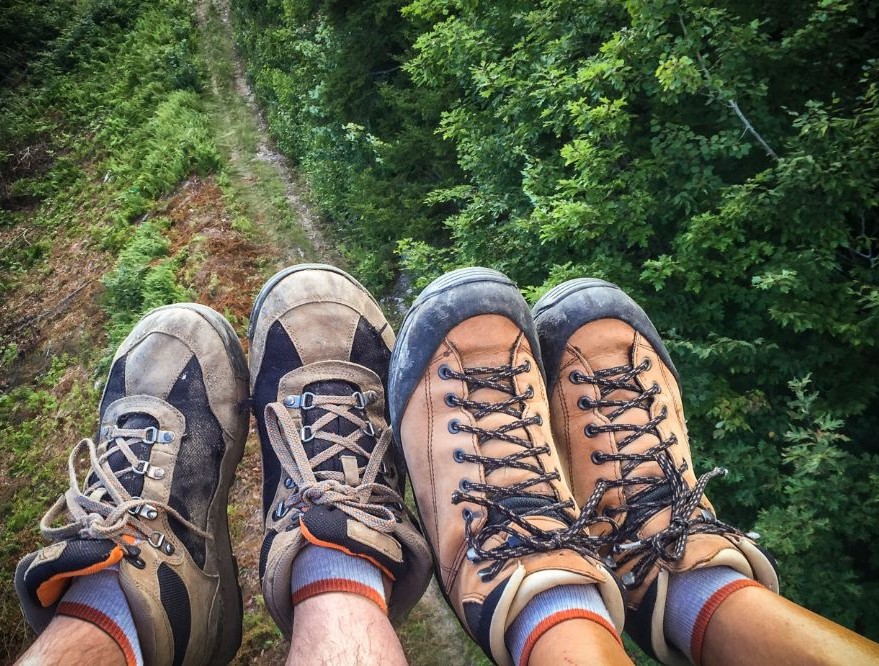Signup for our monthly newsletter and get your FREE "Tactical Gear" Guide
Tactical Boots vs Hiking Boots: Key Differences and Similarities
- Home
- Tactical Boots Advice
- Tactical Boots Vs Hiking Boots

This site contains affiliate links to products. We may receive a commission for purchases made through these links.
Which footwear type would win a tactical boots vs hiking boots faceoff? If you are asking this question, you are not alone.
Tactical gear like boots, knives, and backpacks have been available to civilians for some time now.
They are known for their toughness, so it is only natural for outdoor enthusiasts to consider using them.
That said, the hiking boot is no slouch, either; it is built to withstand extreme conditions and rough terrains.
So, which one should you choose?
To help you answer this question, we will look at their differences and similarities for every key feature.
Table of Contents
Tactical Boots Overview
Before we get to the core of our discussion, we must first make a few things clear. To be more specific, we need to define what each type of footwear is.
There was a time when tactical boots were worn exclusively by military personnel during combat, training, patrol, and other similar tasks.
These activities often involve rugged environments and conditions, and the boots were designed to survive them.
They are made from durable materials like heavy-duty leather, up to 1000D nylon, and high-quality rubber.
At the same time, they provide comfort and support by using ethylene vinyl acetate or polyurethane inside.
All these components come together to make a lightweight but durable boot that protects and supports the feet.
Thanks to improvements in technology and the emergence of innovative materials, manufacturers were able to make these boots available to civilians.
People have been wearing them for a long time now, experiencing all the benefits that this footwear has to offer.
Hiking Boots Overview
Hiking boots are exactly what they sound like: boots made for hiking. They often look rugged, which appeals to most outdoor enthusiasts.
That said, there is more to hiking boots than just their aesthetics.
These boots provide balance and traction, allowing you to maintain a secure foothold on a wide variety of surfaces.
Most brands feature a thick sole, which ensures stability and prevents ankle injuries.
These features will come in very handy if you are hiking a particularly challenging trail.
That said, you will notice that they are typically shorter than tactical boots when it comes to the upper height.
In terms of materials, hiking boots are quite similar to tactical boots.
They use some form of durable leather and Cordura nylon for the uppers and EVA or PU for midsoles and insoles.
There are some differences in the construction, though, which lead to a few variations in quality and performance.
Tactical Boots vs Hiking Boots
At this point, you probably have some idea of the similarities and differences between both types of footwear.
Then again, it is likely not enough to help you decide whether you should lean one way or the other.
In that case, here’s a closer look at the tactical boots vs hiking boots comparison:

Durability
Both types of boots use the same materials, like full-grain leather (nubuck), split-grain leather (suede), strong nylon, rubber (often Vibram), and more.
As a result, they perform at around the same level in terms of durability. They can withstand the normal wear and tear that come with heavy use.
This is understandable, as hiking in the forest with a heavy backpack is somewhat similar to rucking in the jungle (minus the combat, of course).
Both situations demand a lot from footwear in terms of durability.
So, as long as you buy either one from a reputable supplier, you can expect it to last at least a few years.
On top of this, both tactical and hiking boots can survive being exposed to extreme conditions and the elements.
Safety
Again, both types of boots are quite similar if you look at them from the perspective of safety.
They both provide ample protection against puncture, which comes in handy if you’re walking on rocky terrains.
Both types of boots also provide shock absorption, keeping your feet safe from chronic foot injuries.
That said, tactical boots take it one notch higher when it comes to protection against compression.
Many have either a steel or composite toe cap, which keeps your toes from being crushed by heavy objects.
In contrast, most hiking boots only have rubber rands to protect your toes.
Also, tactical boots have taller uppers and can offer more support for your ankles.
So, if you happen to lose your footing, you won’t be as vulnerable to sprains, even if you’re carrying a fully-loaded tactical backpack.
Comfort
Whether you’re carrying out a mission in the desert or hiking a punishing trail, your feet will be under constant attack by pressure and repeated impact.
Your shoes must be up to the task and able to relieve much of the stress on your feet.
Both the tactical and hiking boots have you covered on this front. They use similar materials for the insole and the midsole, like the EVA or PU.
These materials do an excellent job of providing cushion and taking the brunt of the forces your feet are subjected to.
What’s more, EVA foam is a breathable material that helps keep your feet cool and dry even in warm climates.
In terms of comfort, both types are evenly matched, so it all boils down to which brand goes the extra mile by offering additional features.
Weight
Tactical and hiking boots are generally lighter compared to traditional shoes.
This quality is expected from both types of footwear, given how mobility and speed are crucial to their applications.
You can’t be effective on your mission or a hiking trail if your boots are weighing you down from start to finish.
That said, hiking boots have a slight advantage over tactical boots in this round of comparison.
That is because, all other things being equal, tactical boots use a bit more materials.
Remember that they generally have taller uppers, typically ranging between eight to 10 inches. They also have steel or composite toe caps, adding more weight.
Note that the differences might be slight and would vary from one manufacturer to another.
However, if you want to nitpick, hiking boots have a slight upper hand.
Traction
Tactical and hiking boots have similar applications in terms of terrain, weather conditions, and other similar criteria.
Consequently, they both perform at a high level when it comes to the grip of their outsoles.
Most reputable brands offer slip resistance, even on oily surfaces. They also provide great traction on icy, muddy, or rocky surfaces.
One of the first things you need to think about is the material of the outsole.
Since both types of footwear use high-quality rubber, they more or less cancel out in this aspect.
The difference lies in the tread or lugs, which are patterns that form indentations on the bottom.
Tactical boots often have multi-terrain treads and reinforced soles, offering more grip on steep climbs.
They also have padded collars, which help protect the ankles as you navigate uneven ground.
Breathability
When you are rucking or hiking, you won’t be able to control your environment or the conditions around you.
If it gets hot, you have no choice but to endure it.
That said, your gear must be able to make things a bit easier for you. Both tactical and hiking boots do a good job at it.
Their EVA midsole, in particular, is breathable and quite effective in regulating temperature.
It can help out a lot in keeping your feet cool, even after hours of walking, running, or standing.
In addition, most brands use breathable materials for the uppers, especially the lining.
Finally, a lot of manufacturers today add a thin layer of insulation in their boots, which is very helpful when things start to heat up.
Water Resistance
Whether you are in military service, law enforcement, or simply outdoor recreation, you need to keep your feet dry.
Water makes a lot of surfaces slippery, but if your feet are soaking wet inside your boots, this increases friction.
It could lead to a long list of foot problems, including sores and blisters.
That’s because your skin rubs against the inner surface of your shoe when you walk, run, or even just stand.
Plus, prolonged exposure to moisture promotes fungal growth on your feet. Over time, it can also result in sores and infections.
Cost
Another thing you must consider when choosing between tactical and hiking boots is the cost.
It varies greatly for both types of boots, so whichever you decide to get, you’ll surely find a pair that suits your budget.
That said, tactical boots have a bit more to offer, such as better protection and all-terrain performance.
Naturally, these features involve using additional materials, which increases the cost a bit.
That is why tactical boots are generally more expensive than hiking boots, though not by much.
Making The Right Choice
Tactical and hiking boots are very similar in terms of build and application, and their differences are subtle.
At the end of the day, your choice will depend on your preference or what activity you wish to perform.
If you think protection is of utmost importance, then the tactical boot is the better option.
But if you want a more lightweight and affordable pair of shoes, consider buying hiking boots.
